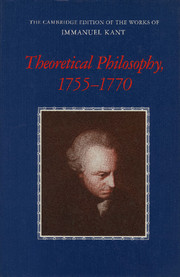Book contents
- Frontmatter
- Contents
- General editors' preface
- Preface
- Guide to abbreviations
- General introduction
- Introductions to the translations
- Résumés of the works
- A NEW ELUCIDATION OF THE FIRST PRINCIPLES OF METAPHYSICAL COGNITION (1755)
- THE EMPLOYMENT IN NATURAL PHILOSOPHY OF METAPHYSICS COMBINED WITH GEOMETRY, OF WHICH SAMPLE I CONTAINS THE PHYSICAL MONADOLOGY (1756)
- AN ATTEMPT AT SOME REFLECTIONS ON OPTIMISM (1759)
- THE FALSE SUBTLETY OF THE FOUR SYLLOGISTIC FIGURES (1762)
- §1 General concept of the nature of syllogisms
- §2 Concerning the supreme rules governing all syllogisms
- §3 Concerning pure and mixed syllogisms
- §4 In the so-called first figure only pure syllogisms are possible. In the remaining three figures nothing but mixed syllogisms is possible
- §5 The logical division of the four syllogistic figures is a piece of false subtlety
- §6 Concluding reflection
- THE ONLY POSSIBLE ARGUMENT IN SUPPORT OF A DEMONSTRATION OF THE EXISTENCE OF GOD (1763)
- ATTEMPT TO INTRODUCE THE CONCEPT OF NEGATIVE MAGNITUDES INTO PHILOSOPHY (1763)
- INQUIRY CONCERNING THE DISTINCTNESS OF THE PRINCIPLES OF NATURAL THEOLOGY AND MORALITY (1764)
- M. IMMANUEL KANT'S ANNOUNCEMENT OF THE PROGRAMME OF HIS LECTURES FOR THE WINTER SEMESTER 1765 — 1766 (1765)
- DREAMS OF A SPIRIT-SEER ELUCIDATED BY DREAMS OF METAPHYSICS (1766)
- CONCERNING THE ULTIMATE GROUND OF THE DIFFERENTIATION OF DIRECTIONS IN SPACE (1768)
- ON THE FORM AND PRINCIPLES OF THE SENSIBLE AND THE INTELLIGIBLE WORLD [INAUGURAL DISSERTATION] (1770)
- Factual notes
- Bibliographies of editions and translations
- Glossary
- Biographical-bibliographical sketches of persons mentioned by Kant
- Index
§1 - General concept of the nature of syllogisms
Published online by Cambridge University Press: 18 December 2014
- Frontmatter
- Contents
- General editors' preface
- Preface
- Guide to abbreviations
- General introduction
- Introductions to the translations
- Résumés of the works
- A NEW ELUCIDATION OF THE FIRST PRINCIPLES OF METAPHYSICAL COGNITION (1755)
- THE EMPLOYMENT IN NATURAL PHILOSOPHY OF METAPHYSICS COMBINED WITH GEOMETRY, OF WHICH SAMPLE I CONTAINS THE PHYSICAL MONADOLOGY (1756)
- AN ATTEMPT AT SOME REFLECTIONS ON OPTIMISM (1759)
- THE FALSE SUBTLETY OF THE FOUR SYLLOGISTIC FIGURES (1762)
- §1 General concept of the nature of syllogisms
- §2 Concerning the supreme rules governing all syllogisms
- §3 Concerning pure and mixed syllogisms
- §4 In the so-called first figure only pure syllogisms are possible. In the remaining three figures nothing but mixed syllogisms is possible
- §5 The logical division of the four syllogistic figures is a piece of false subtlety
- §6 Concluding reflection
- THE ONLY POSSIBLE ARGUMENT IN SUPPORT OF A DEMONSTRATION OF THE EXISTENCE OF GOD (1763)
- ATTEMPT TO INTRODUCE THE CONCEPT OF NEGATIVE MAGNITUDES INTO PHILOSOPHY (1763)
- INQUIRY CONCERNING THE DISTINCTNESS OF THE PRINCIPLES OF NATURAL THEOLOGY AND MORALITY (1764)
- M. IMMANUEL KANT'S ANNOUNCEMENT OF THE PROGRAMME OF HIS LECTURES FOR THE WINTER SEMESTER 1765 — 1766 (1765)
- DREAMS OF A SPIRIT-SEER ELUCIDATED BY DREAMS OF METAPHYSICS (1766)
- CONCERNING THE ULTIMATE GROUND OF THE DIFFERENTIATION OF DIRECTIONS IN SPACE (1768)
- ON THE FORM AND PRINCIPLES OF THE SENSIBLE AND THE INTELLIGIBLE WORLD [INAUGURAL DISSERTATION] (1770)
- Factual notes
- Bibliographies of editions and translations
- Glossary
- Biographical-bibliographical sketches of persons mentioned by Kant
- Index
Summary
To compare something as a characteristic mark with a thing is to judge. The thing itself is the subject; the characteristic mark is the predicate. The comparison is expressed by means of the copula is or are. When used absolutely, the copula designates the predicate as a characteristic mark of the subject. If, however, it is combined with the sign for negation, the copula then signifies that the predicate is a characteristic mark which is incompatible with the subject. In the former case, the judgement is affirmative, whereas in the latter case the judgement is negative. Obviously, in calling the predicate a characteristic mark, we are not saying that it is a characteristic mark of the subject, for that is only the case with affirmative judgements. What we are saying is that the predicate is regarded as a characteristic mark of some thing or other, though, in the case of a negative judgement, it contradicts the subject of the judgement. Thus, let it be a mind which I am thinking; and let compound be the characteristic mark of something or other. The judgement: A mind is not compound represents this characteristic mark as conflicting with the thing itself.
That which is a characteristic mark of a characteristic mark of a thing is called a mediate characteristic mark of that thing. Thus, necessary is an immediate characteristic mark of God, whereas immutable is a characteristic mark of what is necessary, and a mediate characteristic mark of God. Obviously, the immediate characteristic mark occupies the position of an intermediate characteristic mark (nota intermedia) between the remote characteristic mark and the thing itself, for it is only by its means that the remote characteristic mark is compared with the thing itself. But it is also possible to compare a characteristic mark with a thing negatively, by means of an intermediate characteristic mark, namely, by recognising that something conflicts with the immediate characteristic mark of the thing.
- Type
- Chapter
- Information
- Theoretical Philosophy, 1755–1770 , pp. 89 - 90Publisher: Cambridge University PressPrint publication year: 1992



